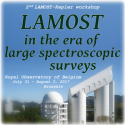Speaker
Dr
Yang Huang
(Peking University)
Description
As a milestone of ‘near-field cosmology’ to fulfill the quest for understanding galaxy formation and evolution, the LAMOST Galactic Spectroscopic Surveys have hitherto collected quality spectra of over 7.5M stars, and this number is still increasing at a rate of 1M per annum. Benefitted from this single largest spectroscopic dataset as well as data from other photometric and spectroscopic surveys, significant progresses have been made on the studies of the kinematics and dynamics of the Milky Way, including
1) Accurate estimates the peculiar velocities of the Sun that define the Local Standard of Rest, the starting point of all Galactic kinematic and dynamic studies;
2) A detailed investigation of the bulk motion of nearby disk stars, in 3-dimension for the first time;
3) Accurate determinations of the Galactic rotation curve out from 8 to 100 kpc and the escape velocity curve from 5 to 14 kpc, as well as of the mass surface density in the solar neighborhood. The above newly obtained accurate measurements allow us to derive the mass distribution of the Milky Way with an unprecedented precision, and thus to map out the potential and (dark) matter distribution of our Galaxy. The accurate local dark matter density delivered by these studies bears on the interpretation of any signals that the ongoing dark matter search experiments are expected to detect;
4) Finally, by combining the LAMOST measurements and the first Gaia data release, a sample of nearly ten thousand local main-sequence turn-off stars has been selected, with very accurate 3-dimensional positions and velocities, as well as chemical composition and age information. The sample allows us to study the local disc(s) in multi-dimensional phase space, yielding pivotal information that help constraint the formation and evolution of the Galactic disc(s).
Primary author
Dr
Yang Huang
(Peking University)
Co-author
Prof.
Xiaowei Liu
(Peking University)

